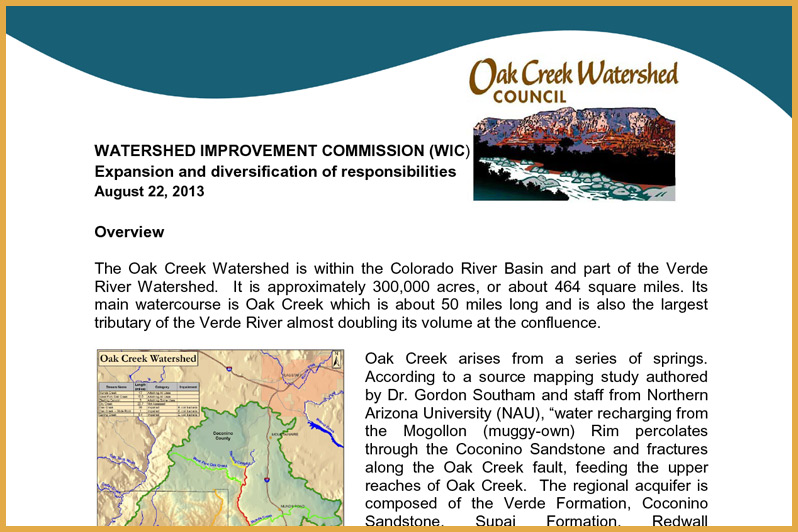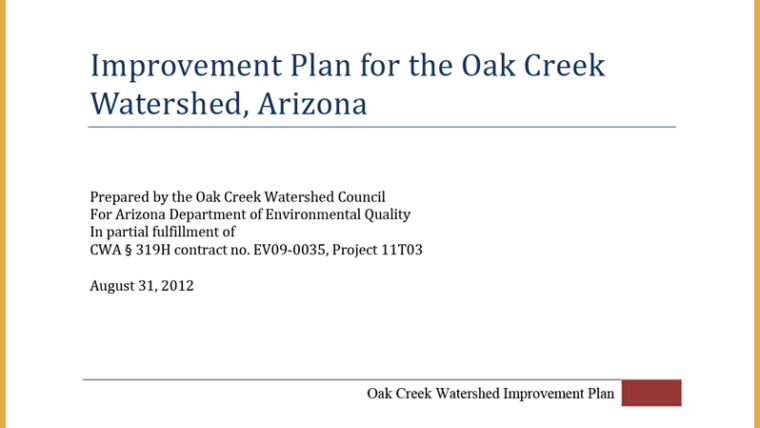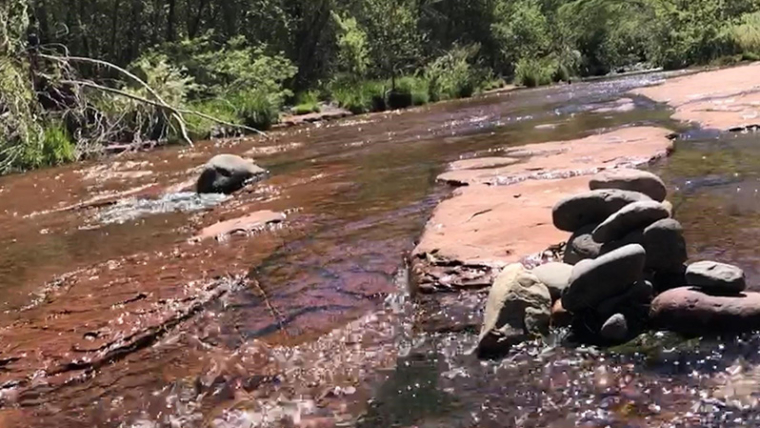Expansion and diversification of responsibilities
August 22, 2013 | PDF version HERE
Overview
The Oak Creek Watershed is within the Colorado River Basin and part of the Verde River Watershed. It is approximately 300,000 acres or about 464 square miles. Its main watercourse is Oak Creek which is about 50 miles long and is also the largest tributary of the Verde River almost doubling its volume at the confluence.
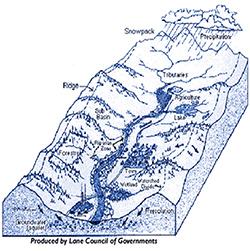
Oak Creek arises from a series of springs. According to a source mapping study authored by Dr. Gordon Southam and staff from Northern Arizona University (NAU), “water recharging from the Mogollon (muggy-own) Rim percolates through the Coconino Sandstone and fractures along the Oak Creek fault, feeding the upper reaches of Oak Creek. The regional aquifer is composed of the Verde Formation, Coconino Sandstone, Supai Formation, Redwall Limestone, Martin Formation and Tapeats Sandstone.
Regional groundwater flow is to the southwest, with the exception of a small region of north and northeasterly flow above the Rim. Groundwater depths range from 200 to 500 feet below land surface. Seeps and springs feed the alluvium along the Creek, supplementing baseflow from the regional aquifer. The portion of the watershed below the Rim experiences little or no recharge since in most month’s evaporation exceeds precipitation. However, during the winter months there may be some recharge since precipitation exceeds evaporation.”
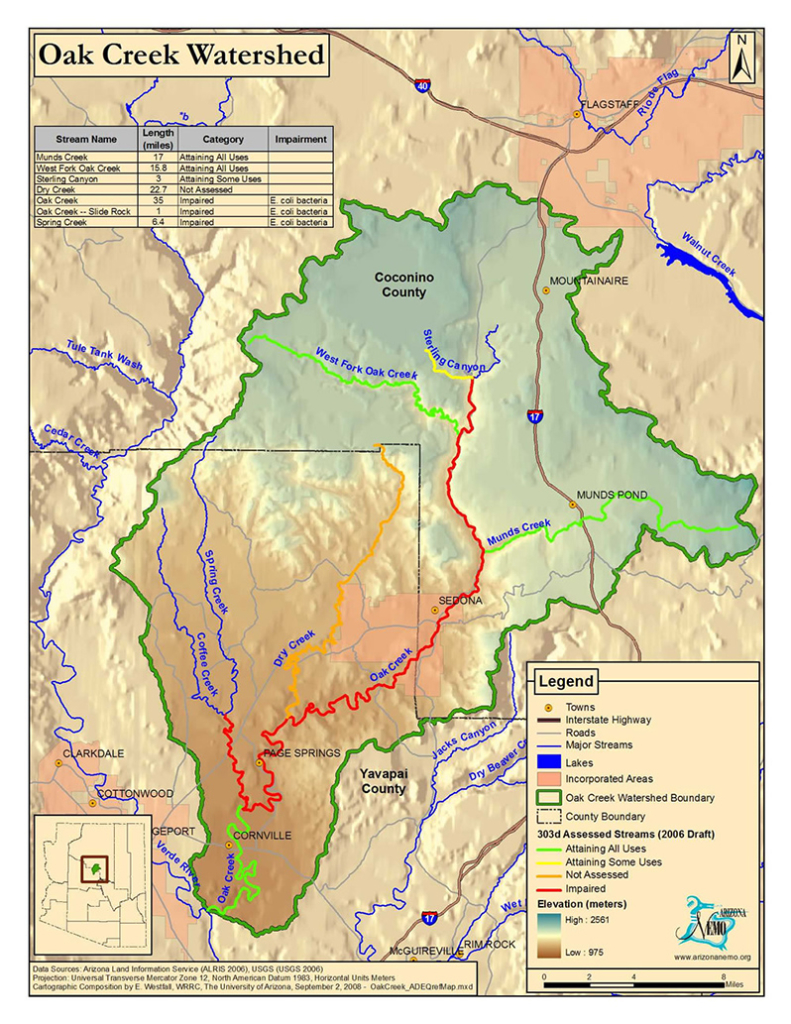
Background
There are over 2100 watersheds across the country and not all are blessed with a management group to protect watershed integrity. The Oak Creek Watershed Council (OCWC) originated 20 years ago under a different name and more modified goals and formalized its structure as a 501(c)(3) nonprofit in 2003. It now has 200 members at active, contributing and stakeholder levels and has developed the reputation for being a “can-do” organization. The common thread among OCWC membership is not only the passion shared for protecting the watershed environment, but the quest to educate all members of our watershed community that water controls our destiny and responsibility for its stewardship is shared by each of us.
The OCWC membership includes citizen scientists, consultants, hydrologists, geologists, engineers, professionals with varied expertise and a volunteer force—Friends of Oak Creek. The OCWC partners with all levels of government as well as other community organizations in its projects and activities including the Sedona Chamber of Commerce and the Sedona Community Foundation. A common goal is to support sustainable tourism and at the same time address its impacts, as well as tackle other water issues of the community from a short- and long-term perspective.
The Oak Creek Watershed Improvement Commission (OCWIC or just WIC) was formed in 2009 representing a larger group of stakeholders. Their original purpose was to provide oversight to the Oak Creek Watershed Council in the development of the Oak Creek Watershed Improvement Plan (OCWIP) (Article OCWIP for Public Review). The Plan was approved by the Arizona Department of Environmental Quality (ADEQ) in September 2012. Arizona has been caught in the grips of a drought for over 20 years with no letup in sight, and the overall demand for water in the Colorado River Basin is now projected to surpass supply. Publicity of this situation is critical, and the need for cooperation among all levels of government, community groups and citizens is urgent.
Water quantity is not the only issue that the Oak Creek Watershed faces in the future. The water quality of Oak Creek continues to be stressed throughout each year mainly by the cumulative effects of concentrated recreation, wildlife and pet feces, septic leakage, stormwater runoff and sediment reservoirs. Successful implementation of BMPs noted in the OCWIP will help to alleviate the exceedance of E. coli and several projects are currently underway by OCWC that are funded by the Oak Creek Outreach Grant (OCOG) through ADEQ/EPA under the Clean Water Act.
The Oak Creek Watershed Council desires to continue to rely on guidance, direction and advice from the Watershed Improvement Commission in tackling watershed issues and thereby wishes to expand the WIC and its responsibilities to more accurately reflect current watershed challenges including, but not limited to: water quality, quantity and conservation, watershed restoration, and the social, economic and environmental impacts on the watershed community.
Water issues have reached a turning point and have the highest priority in our community. The expansion of the WIC, and its responsibilities, is therefore very important to OCWC, and the watershed community, for the future. The expanded WIC will provide oversight, advice, strategic planning ideas for the Board of Directors to act upon. In turn, the Board will collaborate with government entities and other community groups, as well as delegate and seek assistance from OCWC members and volunteers to implement their resulting policies through activities, events and projects supported by sustainable funding efforts.
Mission Statement and Purpose
The Watershed Improvement Commission (WIC) shall advise the Oak Creek Watershed Council (OCWC) regarding policies, programs, regulations and strategies that will increase public awareness, knowledge and action though best management practices (BMPs) in water sustainability and water quality protection with measurable outcomes to enhance and enrich our watershed community.
The WIC is charged with the following roles and responsibilities:
- Provide oversight and advice regarding OCWC grants and activities.
- Provide oversight on the development and implementation of outreach and education programs that inform, engage, and promote sustainable water practices and water quality protection.
- Review and propose sustainable water policies. Evaluate and make recommendations to OCWC regarding existing and potential new regulations, incentive programs and policy documents to further the goal of water sustainability.
- Advise OCWC on policy matters related to sustainable practices
including:
- Water (instream flow, consumption, supply, quality, conservation, wastewater, grey water, water policy, education, rainwater, stormwater
- harvesting)
- Sustainable tourism within resource capacity
- Oak Creek ecosystems and watershed restoration
- Other related issues that directly affect sustainable water efforts by OCWC
- Advise OCWC on possible partnerships to implement sustainable water programs within the watershed and support regional sustainability programs.

